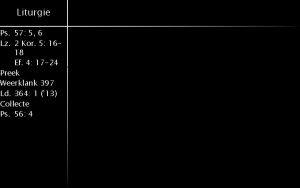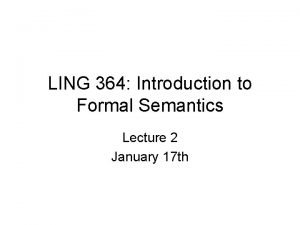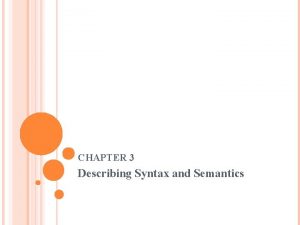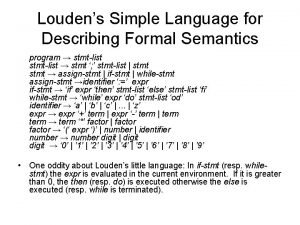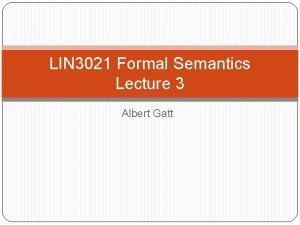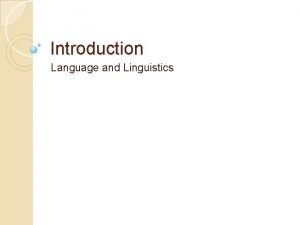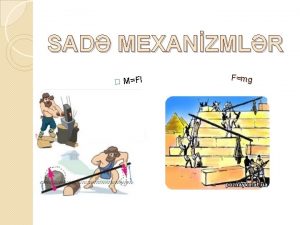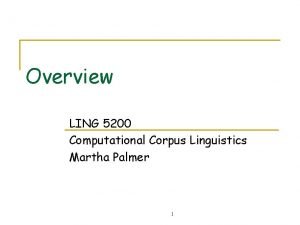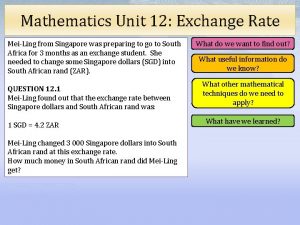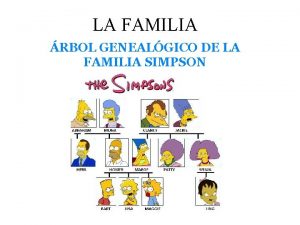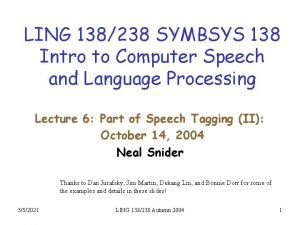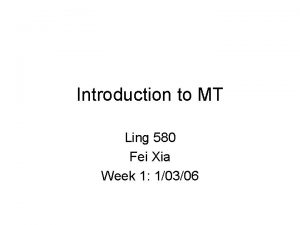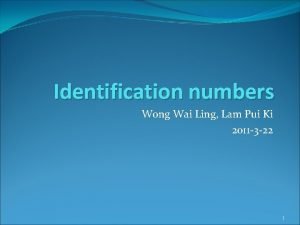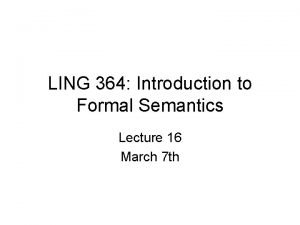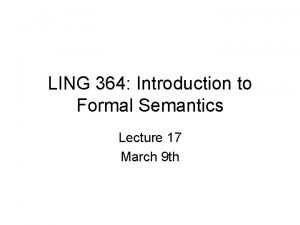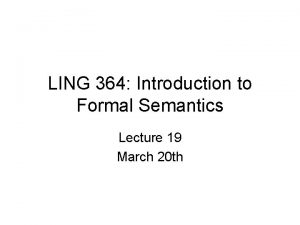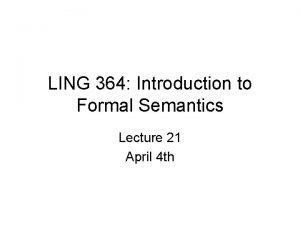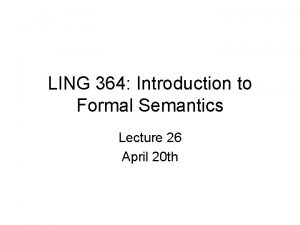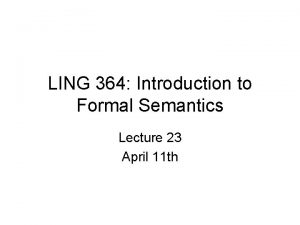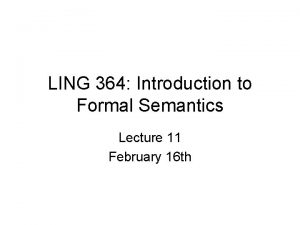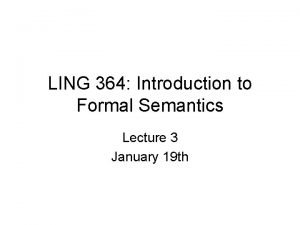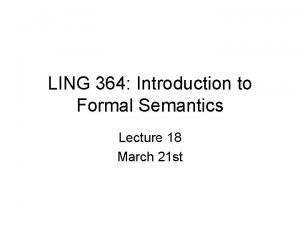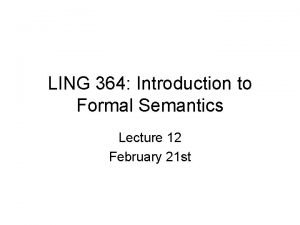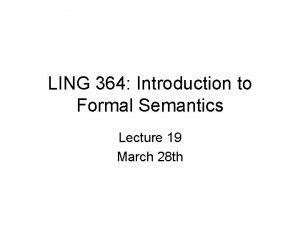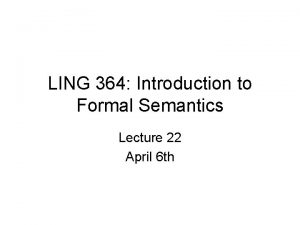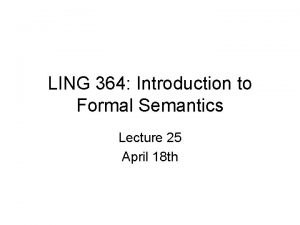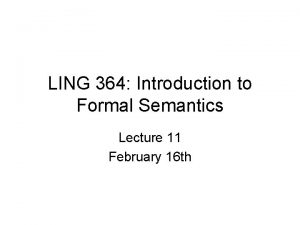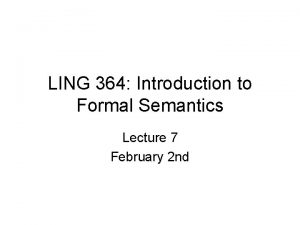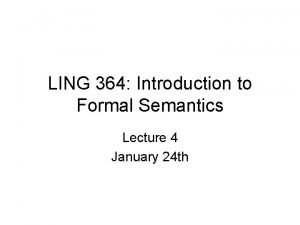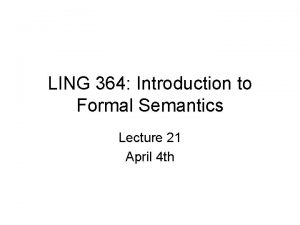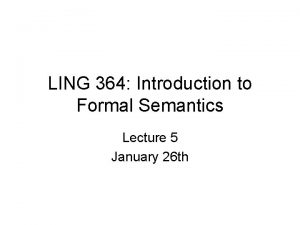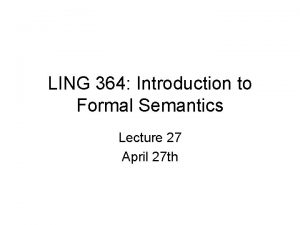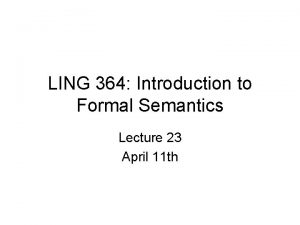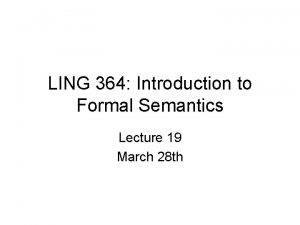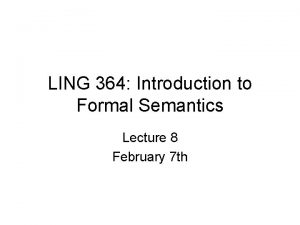LING 364 Introduction to Formal Semantics Lecture 5







![Phrase Structure Rules – John is a [pred student] – John [pred likes] Mary Phrase Structure Rules – John is a [pred student] – John [pred likes] Mary](https://slidetodoc.com/presentation_image_h/07488625f7a4b032a67ee32a3b9ec6ca/image-8.jpg)

























![Quiz • [5 pts] • give meaning fragments for: – – John likes Mary Quiz • [5 pts] • give meaning fragments for: – – John likes Mary](https://slidetodoc.com/presentation_image_h/07488625f7a4b032a67ee32a3b9ec6ca/image-34.jpg)
- Slides: 34

LING 364: Introduction to Formal Semantics Lecture 5 January 26 th

Administrivia • Reminder: – Homework 1 due on tonight (midnight deadline) – questions? ask now • Reading Assignment – Chapter 2: Putting a Meaning Together from Pieces

Last Time • Translating English into logical meaning Mary is a student who is a student? student(mary). ? - student(X).

Last Time • Goal: • demo – formalize language to the degree we can have systems that can understand answer questions wrt. possible worlds – – – to do this we have to be able to (1) parse, and (2) assign meaning to the English input |: john is a student(john). |: mary is a student(mary). |: mary is a baseball fan. baseball_fan(mary). |: who is a student and not a baseball fan? john. | ? - go. |: who is a student and a baseball fan? mary.

Last Time • Syntax: – A formal grammar enables us to logically break down a sentence into its constituent parts X-bar phrase structure subject: [I 2 [NP john] I 1 ] VP: is a student copula: is complement of VP: [NP [DET a][N 1 student]] (predicate NP)

Syntactic Structure • A formal grammar enables us to logically break down a sentence into its constituent parts X-bar phrase structure specifier of CP: [CP [NP who] C 1 ] head of CP: C: auxiliary verb is subject: [I 2 [NP trace] I 1 ] subject is coindexed [1] with specifier of CP VP: [Vtrace] a student verb (trace) is coindexed [2] with is complement of VP: [NP [DET a][N 1 student]]

Phrase Structure Rules • Simple rules: • • • SBar → S subject S → NP VP VP → V NP object V → is NP → DET N NP → Proper. Noun → John DET → a N → student
![Phrase Structure Rules John is a pred student John pred likes Mary Phrase Structure Rules – John is a [pred student] – John [pred likes] Mary](https://slidetodoc.com/presentation_image_h/07488625f7a4b032a67ee32a3b9ec6ca/image-8.jpg)
Phrase Structure Rules – John is a [pred student] – John [pred likes] Mary – John is [pred happy] • which is the predicate? – V (main verb: likes) – Vaux is (copula carries little meaning) – complement of copula is the predicate • Note: – gotta be careful – John is the student • Simple rules: • • • SBar → S subject S → NP VP VP → V NP object V → is NP → DET N NP → Proper. Noun → John DET → a N → student

Phrase Structure Rules • Rules: • • • SBar → Wh. Noun Aux S Wh. Noun → who subject Aux → is S → NPtrace VP empty NPtrace →ε VP → Vtrace NP object Vtrace →ε NP → DET N DET → a N → student plus associations by coindexation between traces and contentful items

Today’s Topics 1. What is a formal grammar? 2. Prolog’s notation formal grammars – Definite Clause Grammars 3. Discussion of Putting a Meaning Together from Pieces 4. Short Quiz

What is a formal grammar? • example NP = Noun Phrase VP = Verb Phrase • example – – – • Sentence → NP VP VP → Verb NP Verb → took NP → the man NP → the book production (or grammar) rule format – LHS → RHS • • • LHS = Left Hand Side → = “expands to” or “rewrites to” RHS = Right Hand Side

What is a formal grammar? • example – – – • derivation – 1. 2. 3. 4. 5. 6. Sentence → NP VP VP → Verb NP Verb → took NP → the man NP → the book • – top-down (one of many) Sentence NP VP NP Verb NP NP took NP the man took the book derivation 1. 2. 3. 4. 5. 6. top-down (alternative) Sentence NP VP the man Verb NP the man took the book

What is a formal grammar? • example – – – • derivation – 1. 2. 3. 4. 5. 6. Sentence → NP VP VP → Verb NP Verb → took NP → the man NP → the book • – bottom-up (one of many) the man took the book NP Verb NP NP VP Sentence derivation 1. 2. 3. 4. 5. 6. bottom-up (alternative) the man took the book the man took NP the man Verb NP the man VP NP VP Sentence

What is a formal grammar? • example – – – • • Sentence → NP VP VP → Verb NP Verb → took NP → the man NP → the book this grammar can generate more than one sentence examples – – the man took the book #the book the man – other sentences? • # = semantically odd add new rule – • Verb → bought examples – – the man took the book the man bought the book #the book the man #the book bought the man # = semantically odd

What is a formal grammar? • example – – – • formally: a grammar contains the following 4 things – • Sentence → NP VP VP → Verb NP Verb → took NP → the man NP → the book <N, T, P, S> • a set of non-terminal symbols (N) • a set of terminal symbols (T) • production rules (P) of the form • a designated start symbol (S) example – Non-terminals: – Terminals: – Start symbol: – Production rules: {Sentence, VP, NP, Verb} {the, man, book, took} Sentence set of LHS → RHS rules

Grammar Rules • Good news! – Prolog supports grammar rules – it knows how to interpret them (directly) – it can use grammar rules supplied by the user to construct a derivation automatically

Prolog Grammar Rules • Prolog’s version of grammar rules: – Definite Clause Grammar (DCG) • Prolog’s format – terminals and non-terminal symbols begin with lowercase letters • e. g. sentence, vp, np, book, took • Note: variables begin with an uppercase letter (or underscore) – --> • is the rewrite symbol – terminals are enclosed in square brackets to distinguish them from non-terminals (list notation) • e. g. [the], [book], [took] – comma (, ) is the concatenation symbol – semicolon (; ) is the disjunction symbol – a period (. ) is required at the end of all DCG rules

Prolog Grammar Rules • example – – – • Sentence → NP VP VP → Verb NP Verb → took NP → the man NP → the book Prolog DCG version – – – • sentence --> np, vp. vp --> verb, np. verb --> [took]. np --> [the], [man]. np --> [the], [book]. Important Note – – don’t enter these rules into the database using assert/1. Use a file.

Prolog Grammar Rules • example – – – sentence --> np, vp. vp --> verb, np. verb --> [took]. np --> [the], [man]. np --> [the], [book]. query: • ? - sentence(S, []). • • S = sentence (as a list) [] = empty list • • i. e. call the start symbol as a predicate and supply two arguments, a list and an empty list

Prolog Grammar Rules • example – – – sentence --> np, vp. vp --> verb, np. verb --> [took]. np --> [the], [man]. np --> [the], [book]. example queries • ? - sentence([the, man, took, the, book], []). • Yes • “the man took the book” is a member of the language generated by the grammar • • ? - sentence([man, took, the, book], []). No • • “man took the book” is not in the grammar “man took the book” is not generated by the grammar

Prolog Grammar Rules • example – – – sentence --> np, vp. vp --> verb, np. verb --> [took]. np --> [the], [man]. np --> [the], [book]. other queries • • ? - sentence([the, man, took, X, book], []). X = the • • • ? - sentence(S, []). S = [the, man, took, the, man] ; S = [the, man, took, the, book] ; S = [the, book, the, man] ; S = [the, book, the, book] ; No

Prolog Grammar Rules • example – – – sentence --> np, vp. vp --> verb, np. verb --> [took]. np --> [the], [man]. np --> [the], [book]. notes – – np --> [the, man]. np --> [the, book]. more grammar det = determiner – – np --> det, [man]. np --> det, [book]. det --> [the]. det --> [a]. OK OK

Prolog Grammar Rules • example – – – – sentence --> np, vp. vp --> verb, np. verb --> [took]. np --> det, [man]. np --> det, [book]. det --> [the]. det --> [a]. query • • ? - sentence(S, []). generates 16 different answers for S • • • 2 choices for det 2 choices for head noun total of 4 different choices for NP 2 choices for NP total = 42= 16 a, the man, book (a|(the))((man)|(book)) as subject, as object

Prolog Grammar Rules • example – – – – sentence --> np, vp. vp --> verb, np. verb --> [took]. np --> det, [man]. np --> det, [book]. det --> [the]. det --> [a]. query • • • ? - sentence([the, man, took|L], []). L = [the, man] ; L = [a, man] ; 4 L = [the, book] ; L = [a, book] ; No choices

Prolog Grammar Rules • example – – – – sentence --> np, vp. vp --> verb, np. verb --> [took]. np --> det, [man]. np --> det, [book]. det --> [the]. det --> [a]. query • ? - sentence([X, man, took, X, book], []). • • • X = the ; X = a ; No 2 choices

Putting a Meaning Together from Pieces • Chapter ties into what we’ve been doing: – driven by syntax – we’re going to compute meaning in parts

Putting a Meaning Together from Pieces • 2. 2 Incomplete Propositions • Shelby barks(shelby). • barks ? ? ?

Putting a Meaning Together from Pieces • 2. 2 Incomplete Propositions • Shelby barks(shelby). • barks(X). – predicate – = unsaturated proposition

Putting a Meaning Together from Pieces • 2. 3 Saturation – Shelby barks(shelby). barks(X). shelby • predication: – relation between predicate barks(X) and its subject shelby – barks is “predicated of” shelby – i. e. barks(X) and X = shelby

Putting a Meaning Together from Pieces • 2. 4 Compositionality – (discrete) infinity and creativity of language (new phrases) – Principle of Compositionality • Meaning(Phrase) = composition of Meaning(Sub. Part 1), Meaning(Sub. Part 2) and so on. . . – Example: Shelby barks

Putting a Meaning Together from Pieces • 2. 5 Syntax and Semantics – Principle of Compositionality can be realized in different ways – Theories of Meaning: • rule-by-rule theories • interpretive theories – Example: • What did John sit on? • John sat on what (+ Wh-phrase movement)

A different kind of example • Think about the meaning of any in: 1. any dog can do that trick 2. I didn’t see any dog 3. *I saw any dog how many meanings does any have? do you see any potential problems for rule-by -rule theories?

A different kind of example • Think about the meaning of any in: 1. any dog can do that trick 2. I didn’t see any dog 3. *I saw any dog how many meanings does any have? a) “free choice” any b) negative polarity item (NPI) any
![Quiz 5 pts give meaning fragments for John likes Mary Quiz • [5 pts] • give meaning fragments for: – – John likes Mary](https://slidetodoc.com/presentation_image_h/07488625f7a4b032a67ee32a3b9ec6ca/image-34.jpg)
Quiz • [5 pts] • give meaning fragments for: – – John likes Mary likes in “John likes Mary” corresponds to likes(john, mary). • give syntactic structures for: – who is a student and not a baseball fan? – who is not a baseball fan or a student?
 1618 lz
1618 lz Estimation word problems
Estimation word problems Bleach 364
Bleach 364 Tm 11-6665-364-12
Tm 11-6665-364-12 Compare procedural semantics and declarative semantics.
Compare procedural semantics and declarative semantics. 01:640:244 lecture notes - lecture 15: plat, idah, farad
01:640:244 lecture notes - lecture 15: plat, idah, farad Formal semantics
Formal semantics General problem of describing syntax
General problem of describing syntax Formal semantics
Formal semantics Formal semantics
Formal semantics Langue and parole
Langue and parole Jin ling cigarettes
Jin ling cigarettes Tərpənən blok
Tərpənən blok Ling
Ling Erin ling
Erin ling Ling oa
Ling oa Mei-ling from singapore was preparing
Mei-ling from singapore was preparing Madre de bart, lisa y maggie
Madre de bart, lisa y maggie Dr ng li ling
Dr ng li ling Nien-ling wacker
Nien-ling wacker Ling shih fu
Ling shih fu Ling simpson
Ling simpson Graph4ai
Graph4ai Archibald maclaren physical education
Archibald maclaren physical education Walter ling
Walter ling Ling
Ling Ling138
Ling138 Ling
Ling Mt ling
Mt ling Lam wai ling
Lam wai ling Ling oa
Ling oa Wang ling relationship
Wang ling relationship Huo lingyu
Huo lingyu Ling rolled
Ling rolled Coronary sinus
Coronary sinus
